Family name: Polygonaceae Jussieu
Synonym(s): Calligonaceae Khalk.; Coccolobaceae F. A. Barkley, nom. nud.; Eriogonaceae G. Don; Persicariaceae Martinov; Rumicaceae Martinov
Common name(s): buckwheat family
*Number of genera/species: 53/1,200
List of genera records in GRIN-Global
Fruit usually an acheneachene:
a dry, indehiscent, one-seeded fruit, with seed attached to pericarp at a single point, derived from a single, superior, simple or compound, one-loculed ovary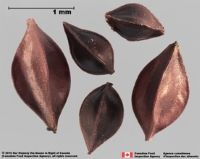 , surrounded by fleshy or dry indehiscentindehiscent:
, surrounded by fleshy or dry indehiscentindehiscent:
not opening on its own, as in a fruit
 , often accrescentaccrescent:
, often accrescentaccrescent:
growing continuously
perianth, rarely a samarasamara:
a winged, indehiscent, dry fruit containing a single (rarely two) seed(s)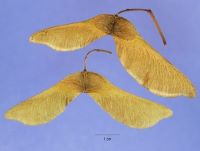 (Afrobrunnichia, Brunnichia), 1–12 mm long, usually trigonoustrigonous:
(Afrobrunnichia, Brunnichia), 1–12 mm long, usually trigonoustrigonous:
3D shape—having three faces that meet at distinct angles; triangular in outline
, sometimes 2-angled (rarely 4), lens-shapedlens-shaped:
2D shape—round and flattened with two curved (convex) surfaces
, ovoidovoid:
3D shape—ovate , or ellipsoidellipsoid:
, or ellipsoidellipsoid:
3D shape—elliptic
, or rarely globoseglobose:
3D shape—more or less spherical (Rheum spp.), coiledcoiled:
(Rheum spp.), coiledcoiled:
(of embryo) linear embryo is very long and bent to form a coil whereby one end of the embryo is on the outside and the other end near the middle of the seed (Calligonum), reniformreniform:
(Calligonum), reniformreniform:
2D or 3D shape—kidney-shaped (Rheum nanum), usually 3-angled and tereteterete:
(Rheum nanum), usually 3-angled and tereteterete:
approximately circular in cross section; width and thickness approximately equal
 or compressedcompressed:
or compressedcompressed:
flattened; in grasses, used to denote compression (not necessarily flattened) either laterally or dorsiventrally
in transection, stylestyle:
in a flower, the narrow and elongated part of the pistil between the stigma and the ovary; sometimes persisting in fruit persistent, rarely beakedbeak:
persistent, rarely beakedbeak:
a usually firm, terminal appendage, sometimes tapered (Petrophyrum), pericarppericarp:
(Petrophyrum), pericarppericarp:
fruit wall or fruit coat
or perianthperianth:
collective term for calyx and corolla of a flower
 winged, if winged, with three laterallateral:
winged, if winged, with three laterallateral:
(of embryo) embryo lies along the side of the seed, generally towards one end; of, at, or from the side; in grasses, can refer to the sides adjacent to the dorsal and ventral sides
wings, usually membranousmembranous:
texture—extremely thin, pliable, and fairly tough
, leatheryleathery:
texture—moderately thick, tough, and very pliable
, or hardened. Fruits with one seed, enclosed by fleshy floral tube (Coccoloba), fleshy tepalstepal:
a member of the perianth, when it cannot be differentiated into a calyx and corolla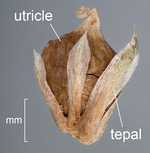 (Muehlenbeckia, Symmeria), leatheryleathery:
(Muehlenbeckia, Symmeria), leatheryleathery:
texture—moderately thick, tough, and very pliable
expanded and flattened floral tube forming wings (Afrobrunnichia, Brunnichia), enlarged receptacle (Oxygonum, Rumex spp.), or dry, accrescentaccrescent:
growing continuously
perianth or calyxcalyx:
the outer whorl of the perianth; all the sepals of a flower , which may develop into wings and/or harden into tubercles (Rumex spp.). Or, fruit with one seed and perianthperianth:
, which may develop into wings and/or harden into tubercles (Rumex spp.). Or, fruit with one seed and perianthperianth:
collective term for calyx and corolla of a flower
 not enlarged in fruit (e.g. Polygonum). Pericarppericarp:
not enlarged in fruit (e.g. Polygonum). Pericarppericarp:
fruit wall or fruit coat
black, brown, gray, purple-red, red, or yellow, dulldull:
reflecting only a low proportion of incident light, with no apparent sheen , shinyshiny:
, shinyshiny:
uniformly reflecting a high proportion of incident light at all angles , or opaqueopaque:
, or opaqueopaque:
not transmitting light
, crustaceouscrustaceous:
texture—thin, dry, indurate, and brittle
or thin, glabrousglabrous:
without hairs
or pubescentpubescent:
surface relief—bearing hairs
. Perianthperianth:
collective term for calyx and corolla of a flower
 derived wings maybe different color than acheneachene:
derived wings maybe different color than acheneachene:
a dry, indehiscent, one-seeded fruit, with seed attached to pericarp at a single point, derived from a single, superior, simple or compound, one-loculed ovary . Surface relief, of pericarppericarp:
. Surface relief, of pericarppericarp:
fruit wall or fruit coat
or more likely persistent perianthperianth:
collective term for calyx and corolla of a flower
 , smooth or groovedgrooved:
, smooth or groovedgrooved:
surface relief—linear depressions that may be single or form a series of grooves over the surface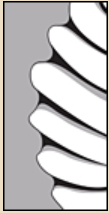 , ribbedribbed:
, ribbedribbed:
surface relief—wide, prominent, linear ridges that are generally rounded and longitudinally situated on the surface , pittedpitted:
, pittedpitted:
surface relief—surface with small depressions in which the areas between the hollows do not take on the appearance of a true reticular net , rough, granulargranular:
, rough, granulargranular:
surface relief—having a grainy surface , punctatepunctate:
, punctatepunctate:
surface relief—dotted with pits or with translucent, sunken glands or with colored dots, similar to pitted , striatestriate:
, striatestriate:
surface relief—having fine, parallel lines, grooves or ridges , prickly, wartywarty:
, prickly, wartywarty:
surface relief—distinct, rounded projections that are large relative to the fruit size; tuberculate, verrucose (Rumex), or with soft or stiff, forked or not bristles (Calligonum spp., Pteropyrum spp.), terminal stellatestellate:
(Rumex), or with soft or stiff, forked or not bristles (Calligonum spp., Pteropyrum spp.), terminal stellatestellate:
star-shaped; with radiating branches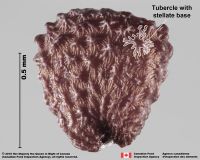 barbs (Fagopyrum snowdenii), or reflexed hornshorn:
barbs (Fagopyrum snowdenii), or reflexed hornshorn:
a straight or curved, slenderly conic or conoidal protrusion, resembling an animal horn
(Rumex spp.).
Seeds globoseglobose:
3D shape—more or less spherical to trigonoustrigonous:
to trigonoustrigonous:
3D shape—having three faces that meet at distinct angles; triangular in outline
, usually angledangular:
2D shape—having sides that meet at acute or obtuse angles
, tereteterete:
approximately circular in cross section; width and thickness approximately equal
 , lens-shapedlens-shaped:
, lens-shapedlens-shaped:
2D shape—round and flattened with two curved (convex) surfaces
, or angledangular:
2D shape—having sides that meet at acute or obtuse angles
in transection, 1–7 mm long. Margins, if winged. Seed coat black, brown, or red- or yellow-brown, dulldull:
reflecting only a low proportion of incident light, with no apparent sheen , glabrousglabrous:
, glabrousglabrous:
without hairs
, smooth.
Embryo well developed, completely or partially filling seed coat, peripheralperipheral:
(of embryo) embryo is curved around the outer edge of the seed, near the seed coat
, axileaxile:
on or of the axis
and excentric, or rarely centric, linearlinear:
(shape) long, narrow, and uniform in width; (of embryo) embryo is straight and much longer than wide , straight or often curvedcurved:
, straight or often curvedcurved:
(of embryo) linear embryo is curved into an arch or horseshoe with the ends far apart , usually lying in one of the angles of the seed. Cotyledons thin, foliaceous or not, flat, once-folded, or convoluted.
, usually lying in one of the angles of the seed. Cotyledons thin, foliaceous or not, flat, once-folded, or convoluted.
Endosperm copious, opaqueopaque:
not transmitting light
or transparent, fleshy, horny, mealymealy:
loose, dry, and disintegrating in finely granular
pieces like meal or flour
, or granulargranular:
surface relief—having a grainy surface , sometimes ruminateruminate:
, sometimes ruminateruminate:
testa or seed coat folded into the endosperm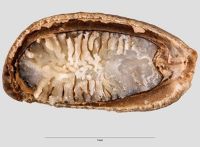 .
.
Many species of Polygonum are weedy and spreads by seed reproduction. It often forms dense clumps or predominant populations in suitable habitats.
Noxious Weeds: USA Federal Noxious Weed List, terrestrial, Rumex hypogaeus T.M. Schuster & Reveal (=*Emex australis Steinh.), Rumex spinosa L. (=*Emex spinosa (L.) Campdera).
*Name listed in USA Federal Noxious Weed Regulations and tool linked below.
Federal Noxious Weed Disseminules of the US tool provides descriptions and images of these species. Aquarium & Pond Plants of the World tool includes descriptions and images of genera, which may be encountered.
| Fruit | |
| Type | acheneachene: a dry, indehiscent, one-seeded fruit, with seed attached to pericarp at a single point, derived from a single, superior, simple or compound, one-loculed ovary  |
| Size range | 1–12 mm long |
| Shape(s) | usually trigonoustrigonous: 3D shape—having three faces that meet at distinct angles; triangular in outline , also 2-angled (rarely 4), lens-shapedlens-shaped: 2D shape—round and flattened with two curved (convex) surfaces , globoseglobose: 3D shape—more or less spherical  , ovoidovoid: , ovoidovoid:3D shape—ovate  , ellipsoidellipsoid: , ellipsoidellipsoid:3D shape—elliptic , coiledcoiled: (of embryo) linear embryo is very long and bent to form a coil whereby one end of the embryo is on the outside and the other end near the middle of the seed  , reniformreniform: , reniformreniform:2D or 3D shape—kidney-shaped  |
| Texture | crustaceouscrustaceous: texture—thin, dry, indurate, and brittle or thin |
| Surface relief | smooth, groovedgrooved: surface relief—linear depressions that may be single or form a series of grooves over the surface  , ribbedribbed: , ribbedribbed:surface relief—wide, prominent, linear ridges that are generally rounded and longitudinally situated on the surface  , pittedpitted: , pittedpitted:surface relief—surface with small depressions in which the areas between the hollows do not take on the appearance of a true reticular net  , rough, granulargranular: , rough, granulargranular:surface relief—having a grainy surface  , punctatepunctate: , punctatepunctate:surface relief—dotted with pits or with translucent, sunken glands or with colored dots, similar to pitted  , striatestriate: , striatestriate:surface relief—having fine, parallel lines, grooves or ridges  , prickly, wartywarty: , prickly, wartywarty:surface relief—distinct, rounded projections that are large relative to the fruit size; tuberculate, verrucose  , with bristles, barbs, or reflexed hornshorn: , with bristles, barbs, or reflexed hornshorn:a straight or curved, slenderly conic or conoidal protrusion, resembling an animal horn |
| Color(s) | black, brown, gray, purple-red, red, yellow |
| Unique features | Usually trigonoustrigonous: 3D shape—having three faces that meet at distinct angles; triangular in outline achenesachene: a dry, indehiscent, one-seeded fruit, with seed attached to pericarp at a single point, derived from a single, superior, simple or compound, one-loculed ovary  often winged or enclosed by persistent, accrescentaccrescent: often winged or enclosed by persistent, accrescentaccrescent:growing continuously , dry or fleshy perianthperianth: collective term for calyx and corolla of a flower  , if dry maybe winged. , if dry maybe winged. |
| Seed | |
| Size range | 1–7 mm long |
| Shape(s) | trigonoustrigonous: 3D shape—having three faces that meet at distinct angles; triangular in outline , ovoidovoid: 3D shape—ovate  , cordiformcordiform: , cordiformcordiform:3D shape—heart-shaped , ellipsoidalellipsoid: 3D shape—elliptic , globoseglobose: 3D shape—more or less spherical  |
| Surface relief | smooth |
| Color(s) | black, brown, red-brown, yellow-brown |
| Unique features | Dulldull: reflecting only a low proportion of incident light, with no apparent sheen  brown or black, glabrousglabrous: brown or black, glabrousglabrous:without hairs , smooth seeds tightly adhered to pericarppericarp: fruit wall or fruit coat , with punctatepunctate: surface relief—dotted with pits or with translucent, sunken glands or with colored dots, similar to pitted  hilahilum: hilahilum:on seeds, the scar indicating where the funiculus was attached; on grass caryopses, the scar visible on the outer fruit surface revealing where the seed is attached on the inner fruit wall surface; or in Asteraceae cypselae, the scar visible on the outer fruit wall revealing where the fruit was attached to the receptacle  and copious endosperm. and copious endosperm. |
| Other | |
| Embryo | well developed, completely or partially filling seed coat, peripheralperipheral: (of embryo) embryo is curved around the outer edge of the seed, near the seed coat , axileaxile: on or of the axis and excentric, or rarely centric, linearlinear: (shape) long, narrow, and uniform in width; (of embryo) embryo is straight and much longer than wide  , straight or often curvedcurved: , straight or often curvedcurved:(of embryo) linear embryo is curved into an arch or horseshoe with the ends far apart  , usually lying in one of the angles of the seed. Cotyledons thin, foliaceous or not, flat, once-folded, or convoluted. , usually lying in one of the angles of the seed. Cotyledons thin, foliaceous or not, flat, once-folded, or convoluted. |
| Nutritive tissue | endosperm copious, opaqueopaque: not transmitting light or transparent, fleshy, horny, mealymealy: loose, dry, and disintegrating in finely granular pieces like meal or flour , or granulargranular: surface relief—having a grainy surface  , sometimes ruminateruminate: , sometimes ruminateruminate:testa or seed coat folded into the endosperm  |
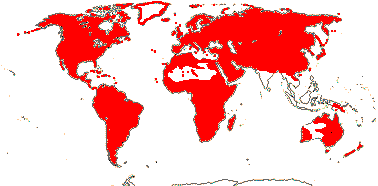
Distribution map courtesy of Angiosperm Phylogeny Website.
Cornejo and Janovec 2010Cornejo and Janovec 2010:
Cornejo F and Janovec J. 2010. Seeds of Amazonian Plants. Princeton University Press, Princeton and Oxford. ; Flora of Australia 2021+Flora of Australia 2021+:
Flora of Australia. Australian Biological Resources Study, Canberra. Accessed January 2021–March 2024. URL: http://www.ausflora.org.au; Flora of North America Editorial Committee 1993+Flora of North America Editorial Committee 1993+:
Flora of North America Editorial Committee, eds. 1993+. Flora of North America North of Mexico [Online]. 22+ vols. Flora of North America Association, New York and Oxford. Accessed January-March 2024. URL: http://beta.floranorthamerica.org.; Kirkbride et al. 2006Kirkbride et al. 2006:
Kirkbride JH, Jr, Gunn CR, and Dallwitz MJ. 2006. Family guide for fruits and seeds, vers. 1.0. Accessed September 2020-January 2022. URL: https://nt.ars-grin.gov/seedsfruits/keys/frsdfam/index.cfm .; Kubitzki et al. 1990+Kubitzki et al. 1990+:
Kubitzki K et al., eds. 1990+. The families and genera of vascular plants. 7+ vols. Berlin etc.; Noxious Weed Regulations 2020Noxious Weed Regulations 2020:
Noxious Weed Regulations. 2020. 7 C.F.R. sect; 360.100-360.600.; PlantNET 2021+PlantNET 2021+:
PlantNET (The NSW Plant Information Network System). 2021+. Royal Botanic Gardens and Domain Trust, Sydney. Accessed January 2021–March 2024. URL: https://plantnet.rbgsyd.nsw.gov.au; Takhtajan 2009Takhtajan 2009:
Takhtajan A. 2009. Flowering plants: Second edition. Springer Nature, Switzerland. 871 pp.; USDA 1980USDA 1980:
United States Dept. of Agriculture (USDA). 1980. Major weed family identification guide. Hyattsville Md, United States ; Zhengyi et al. 2004+Zhengyi et al. 2004+:
Zhengyi W, Raven PH, and Deyuan H. 2004+. Flora of China [online]. 25 vols. Science Press, Beijing China & Missouri Botanical Garden, St. Louis USA. Accessed January–March 2024. http://flora.huh.harvard.edu/china/
*The number of genera and species is based on Christenhusz and Byng 2016Christenhusz and Byng 2016:
Christenhusz MJM and Byng JW. 2016. The number of known plant species in the world and its annual increase. Phytotaxa 261 (3): 201-217. https://doi.org/10.11646/phytotaxa.261.3.1, which may differ from the number of genera in GRIN-Global.